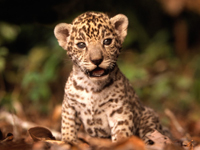

 |

|
 Jaguar |
Jaguar(Mammal) |
 Jaguar Baby |
Jaguar HabitsAdult jaguars are solitary, seeking each other out only during breeding season, when male and female stay together for a short time to mate. A young jaguar stays with its mother for a few years before leaving to find hunting territories of its own.
The size of jaguar's territory depends on food availability. In an area where food is plentiful, such as a forest, a jaguar can survive in a circular area of about 3 miles in diameter. Where food is scarce, it may need to roam over an area of 200 square miles.
Jaguars were once found in an area ranging from Arizona to Argentina, but ruthless hunting has reduced their population. The clearing of forests to build new settlements and pastures for cattle has forced them out of much of their original habitat. Jaguars are thought to be numerous in the upper basin of the Orinoco, in Venezuela, but everywhere else they are in danger of extinction. There are fewer than 200 wild jaguars left in all of Argentina. Soon, the only remaining populations will live in zoos. Although jaguars have a reputation as man-eaters, there are numerous stories about men being followed for miles through the forest by solitary jaguars. These stories give credence to the theory that the animals prefer to escort men off their territory rather than attack them. |
Jaguar CommunicationYoung jaguar have adult vocalizations by one year old (except for calls used in reproductive behavior). There most commonly noted sound is a "grunt" or a "snore" similar to a hoarse barking cough which sounds like "uh uh uh uh", this is used for long distance communication and home range maintenance.
Male grunts are more resounding and stronger than females'. Females' calls become louder when in estrus.
Lower pitched roaring produced by a downwards shift of their larynx (lengthening of the vocal tract) as the animal ages. Other animals whose larynx changes position with development include humans and red deer.
Jaguars have a series of low-intensity, short snorts called prusten or chuffings; are also heard in tigers, snow leopards and clouded leopards. Jaguars develop adult structured calls without learning from other jaguars.
Jaguars also use olfaction or scent Marking in order to communicate. This includes scraping the ground with hind paws, urination , scent and feces marking, tree raking, and head rubbing which function as territory markers and forms of communication. |
Jaguar BreedingVery little is known about the family life of wild jaguars. They have been hunted almost to extinction for their fur. Biologists now find it difficult to study wild jaguars in zoos, where the animals have been bred successfully.
Males and females meet in the wild only to mate. The male leaves as soon as mating is over, and the female brings up the young on her own. She gives birth to one to four cubs, which are blind at birth and weigh only 25- 32 ounces. The cubs begin exploring the world outside the den at about two weeks, when their eyes have opened. The begin hunting with their mother at the age of six months. They remain with her for the first two years before leaving to find a territory of their own in which to hunt. A jaguar is sexually mature at three years of age. |
Jaguar Food & FeedingJaguars hunt mainly on the ground; however they will climb trees to lie in wait for prey. The jaguar can cover short distances rapidly, but it tires quickly. It hunts mainly at night and often surprises its unsuspecting prey. Its food consists mostly of forest animals varying in size from mice to deer. The jaguar is a proficient swimmer and also eats frogs, fish, turtles, and small alligators. It is especially skilled at catching fish, which it does by flipping the fish out onto the riverbank with its paw. Jaguars will also kill domestic animals, particularly where the forest has been cleared for farmland. |
Jaguar Key Facts |
| Size |
| Height: Length: 44-73 in. Tail 18-30 in |
| Weight: Males, 125-250 lb. Females, 100-200 lb |
| Breeding |
| Sexual maturity: 3 years |
| Mating: Non-seasonal in tropics; early autumn in extremes of range |
| Gestation: 93-110 days |
| Number of young: 1-4 cubs |
| Lifestyle |
| Habit: Solitary, except in breeding season, when they come together to mate |
| Diet: Ground-living mammals, domestic stock, fish, frogs, turtles, and small alligators |
| Lifespan: Up to 22 years |
DID YOU KNOW?
|
CAN'T FIND WHAT YOU'RE LOOKING FOR? CLICK HERE!!!